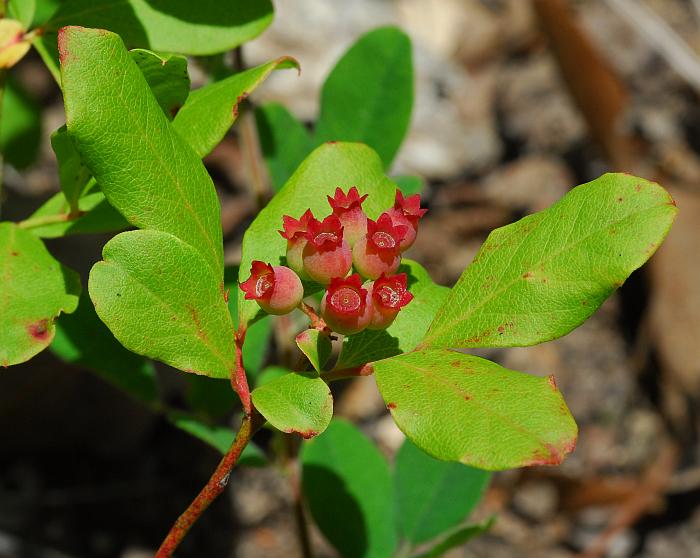Vaccinium pallidum Aiton
Lowbush Blueberry

Native
CC = 4
CW = 5
MOC = 61
© DETenaglia
Vaccinium pallidum AitonLowbush Blueberry | |
 |
Native CC = 4 CW = 5 MOC = 61 |
© DETenaglia |
|
Family - Ericaceae Habit - Shrubs to 1 m tall. Stems - Ascending, branched. Bark reddish brown to greenish brown, smooth, not peeling, sometimes becoming finely longitudinally ridged with age. Twigs glabrous to moderately hairy, sometimes glaucous, green to yellowish green, becoming brown with age. Young twigs densely dotted with minute light spots. Leaves - Alternate, simple, short-petiolate. Petioles to 2-3 mm long, pubescent. Blades 20-50 mm long, 10-25 mm wide, relatively thin, sometimes somewhat stiff but not leathery, elliptic to ovate or obovate, the tip sharply pointed or acutely narrowed to a blunt point, the margins entire or with small, nonglandular teeth toward the tip, sometimes slightly thickened or curled under, otherwise glabrous, the upper surface glabrous or sparsely to moderately hairy along the midvein, not or only slightly waxy, usually at least somewhat shiny, the undersurface dull or slightly shiny, glabrous or sparsely hairy along the main veins, occasionally with reddish glands along the midvein, pale green. Inflorescence - Short racemes, appearing with the new seasons leaves from terminal and axillary buds, lacking leaflike bracts at the base of the flower stalks but with small, scalelike, reddish bracts on the stalks, these often shed as the flowers develop. Flower stalks 3-8 mm long, with a conspicuous swollen joint at the junction with the flower.
Flowers - Calyx lobes 1.2-1.6 mm long, glabrous, often glaucous. Corollas 4-7 mm long, 2-3 mm in diameter, tubular to narrowly urn-shaped, white to greenish white, often pinkish-tinged, glabrous, shallowly 5-lobed, the lobes reflexed. Stamens 10, not exserted, lacking spurs at the filament-anther junction, the filaments flattened, hairy along the margins, the anthers copper-colored, tapered to tubules 1.5-2.0 mm long. Styles 5-6 mm long, slightly exserted. Ovary inferior, 2-locular.
Fruits - Berries globose, glaucous, blue-purple, 4-6 mm in diameter.
Flowering - April - May, occasionally reflowering in October. Habitat - Mesic to dry upland forests and ledges and tops of bluffs, ridges, old fields, on acidic substrates. Origin - Native to the U.S. Lookalikes - V. stamineum, V. arboreum. Other info. - This small, shrubby species is common in the lower half of Missouri, though it is fairly specific to acidic soils. It occurs across most of the eastern U.S. When flowering it is easily recognized by the shape and appearance of the flowers. Recognition at the vegetative state is a little more difficult, but aided by the unique presence of densely spaced, tiny white dots on new twigs (most easily seen with magnification). Another useful character is the density of the leaf venation, which varies markedly among the three Missouri species of Vaccinium. V. arboreum has widely spaced, open venation, whereas in V. stamineum this is tight and dense. The venation of V. pallidum is intermediate between these two. A comparison is shown in the photo below. From left to right the species are V. arboreum, V. stamineum and V. pallidum.
The plant produces a richly flavored blueberry in the summer. These are a real treat to hikers on the rare occasions that the fruits have not already been found and consumed by wildlife. Of the three species discussed above, only V. pallidum produces fruits which are worth eating. The farmed blueberry, V. corymbosum, does not generally occur wild in Missouri, though it was found to have escaped cultivation at one site in Ste. Genevieve County. Photographs taken in the Piney Creek Wilderness, Mark Twain National Forest, Barry County, MO., 4-10-01 (DETenaglia); also at Marble Creek Campground, Madison County, MO, 4-13-2017, and Little Lost Creek Conservation Area, Warren County, MO, 4-15-2017, 6-9-2017, and 6-27-2023 (SRTurner). |